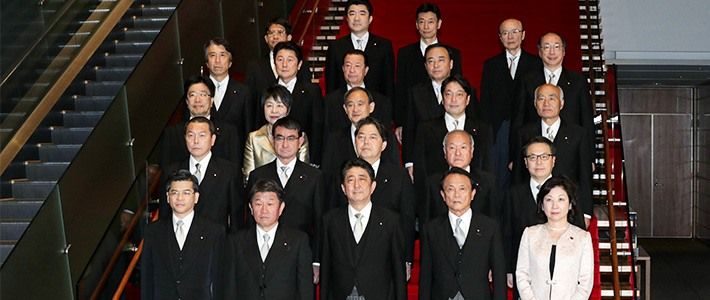
Women Cabinet Ministers in Japan
Politics- English
- 日本語
- 简体字
- 繁體字
- Français
- Español
- العربية
- Русский
The Global Gender Gap Report released in November 2017 by the World Economic Forum ranked Japan 114th out of 144 countries. This was a fall of three places from the previous year. The ranking is based on four categories: economic participation and opportunity, educational attainment, health and survival, and political empowerment. Japan lagged particularly in the last of these categories, ranking 129th for women in parliament and 88th for women in ministerial positions.
2017 Global Equality Ranking
| Category | Ranking of Japan | Score of Japan |
|---|---|---|
| Global index | 114 | 0.657 |
| Economic participation and opportunity | 114 | 0.580 |
| Labor force participation | 79 | 0.781 |
| Wage equality for similar work | 52 | 0.672 |
| Legislators, senior officials and managers | 116 | 0.142 |
| Professional and technical workers | 101 | 0.654 |
| Educational attainment | 74 | 0.991 |
| Literacy rate | 1 | 1 |
| Enrolment in primary & secondary education | 1 | 1 |
| Enrolment in tertiary education | 101 | 0.926 |
| Health and survival | 1 | 0.98 |
| Political empowerment | 123 | 0.078 |
| Women in parliament | 129 | 0.102 |
| Women in ministerial positions | 88 | 0.188 |
| Years with female head of state | 69 | 0 |
Compiled from documents published by the World Economic Forum (excerpts)
The highest possible score is 1 (equality) and the lowest possible score is 0 (inequality).
The first Japanese woman to be appointed a cabinet minister was Nakayama Masa, who became minister of health and welfare in July 1960. Then in July 1962, Kondō Tsuruyo was appointed as minister of state of science and technology. Following that, there was a 22-year gap until the appointment of a female minister of state for the environment. The first time that two women simultaneously held ministerial positions was in 1989. Since July 1998, there has always been at least one female minister. The highest number to date has been five—once at the start of the Koizumi Jun’ichirō administration in April 2001 and then in September 2014 during the current administration of Prime Minister Abe Shinzō.
Certain ministerial posts are more likely to be filled by women. By far, the most commonly held position is minister of the environment (known as minister of state for the environment until 2000), with nine women appointed. The next is minister of justice with six women having held that position. Prior to the 2001 central government reform, positions heading agencies and thereby regarded as less important—such as the ministers of state for science and technology, for the environment, and for economic planning—were often given to women.
More recently, many of the appointments for women have been as ministers of state for special missions. While they deal with important topics like the declining birthrate, gender equality, women’s empowerment, and consumer affairs and food safety, they are posts with comparatively lighter workloads.
In contrast, very few women are appointed to more crucial posts within the cabinet. Two posts that have never been filled by women are minister of finance and minister of agriculture, forestry, and fisheries. The first ever woman minister of economy, trade, and industry was Obuchi Yūko, appointed by Prime Minister Abe in September 2014; however, not even two months had passed before she had to resign due to violating the political funds control law. Only two women have been appointed as minister of health, labor, and welfare, as is the case for minister of foreign affairs.
The underlying cause is that there are too few female members in the Diet. In the October 2017 Lower House elections (set at 465 members), 209 women ran as candidates with 23 being elected to single-member constituencies and 24 by proportional representation, making a total of 47. This makes the ratio of women in the lower house 10.1%. Up to now, the largest number of women elected as Diet members was 54, a ratio of 11.25%, in 2009. Due to the lack of female Diet members, women are often appointed as cabinet ministers before they have gained enough experience as politicians, meaning the posts have to be those with lighter responsibilities.
In May 2018, a law on promotion of gender equality in the political field was enacted and put into effect. Aimed at advancement of women in politics, it expects political parties and organizations to do their best to put forward an equal number of men and women candidates. This will be a test of each party’s level of commitment as while cooperation is required, no penalties are incurred for noncompliance.
(Translated from Japanese. Banner photo: Commemorative photo taken of ministers following the first cabinet meeting of the fourth Abe cabinet in November 1, 2017. The two women ministers are Minister of Internal Affairs and Communications Noda Seiko and Minister of Justice Kamikawa Yōko. © Jiji.)